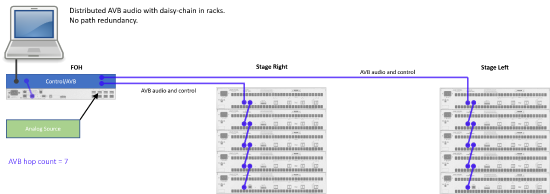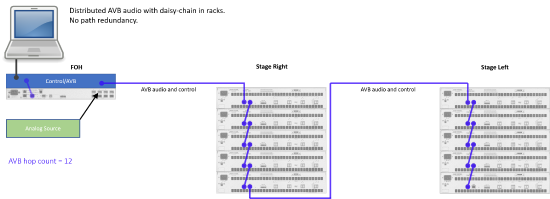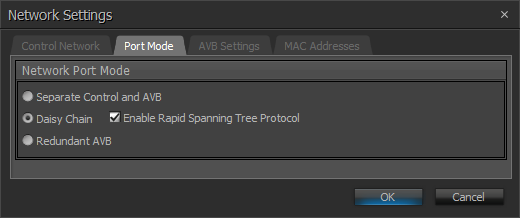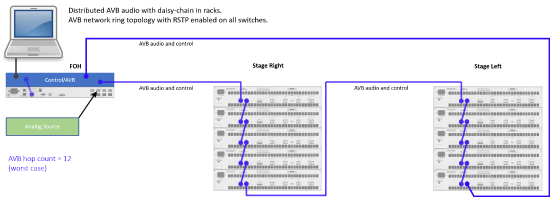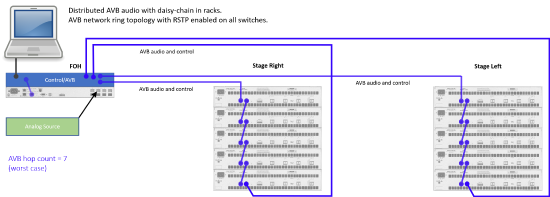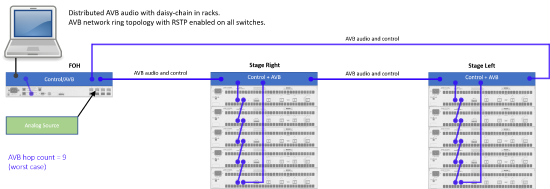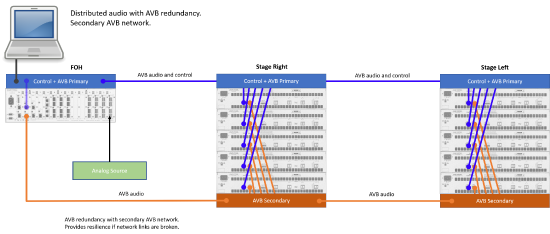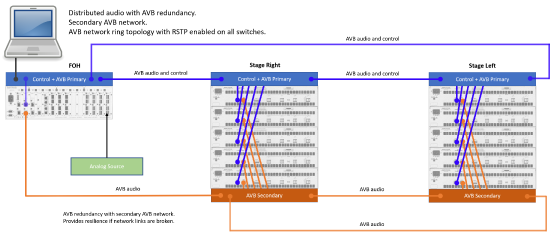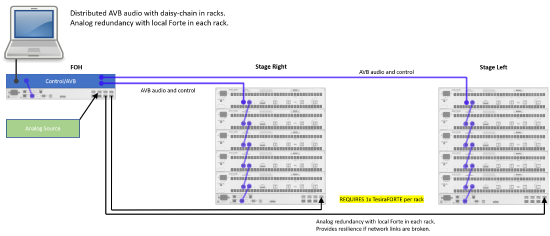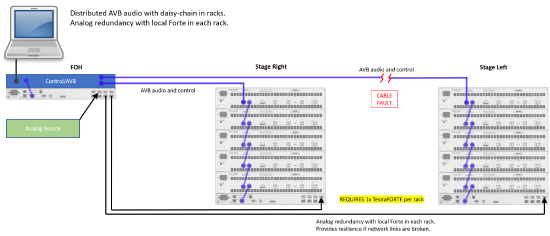TesiraXEL amplifiers - Signal path redundancy concepts
Amplifiers in performance venues should always have duplicate audio signal paths available. In the event of a fault in one path, the program material can be routed to the amplifiers via a second path.
TesiraXEL can support signal path redundancy two ways:
- the use of independent, redundant AVB primary and secondary networks
- using analog backup signal paths to a TesiraFORTÉ in the local rack.
No redundant signal path
Here are two examples of systems that do not have a redundant signal path. Any cable fault will affect all downstream devices. This may not be viewed as acceptable behavior.
RSTP redundant cable paths
TesiraXEL amplifiers support RSTP (Rapid Spanning Tree Protocol). RSTP can be enabled in Daisy Chain mode in the amplifier's Network Settings > Port Mode tab under Device Maintenance. Other network hardware must also have RSTP enabled to allow ring topologies without causing network broadcast storms.
AVB redundancy
TesiraXEL amplifiers have dual AVB ports and support AVB redundancy via a primary and secondary AVB network structure.
- Control data is only passed via the primary network. Logic IO connections on the amplifiers will still function for remote chassis mute if enabled.
- Only Tesira devices with AVB secondary ports can participate in a redundant AVB network.
The primary and secondary networks should be completely independent so that a change on one network will not affect the performance of the other.
Tesira devices with AVB redundancy are always sending and receiving the secondary AVB streams. The streams share the same stream ID numbers, but each network port gives their streams a unique MAC address prefix, creating a unique stream ID for primary and secondary streams. The use of unique stream IDs allows the two networks to touch without the streams conflicting, but it will double the number of AVB streams on the network.
The same device provides the AVB master clock on the primary and secondary networks. For this reason, in any system that has devices with primary and secondary AVB ports, one of these devices will always be the AVB master.
In the event that a stream is lost on the primary network, it will immediately fail over to the secondary stream. When the primary stream is restored, the device will revert back to the primary stream.
Incorporating a combination of ring topology and AVB redundancy gives the highest level of path protection.
Analog failover path
In some cases, it may be desirable to provide an analog backup line to the amplifier racks, rather than using AVB redundancy. This can be implemented with the addition of a TesiraFORTÉ in each amplifier rack location.
This necessitates a more complex file using logic and processing that allows the amplifier-side TesiraFORTÉ to unmute the analog inputs only if the AVB stream is lost. This should be done via monitoring a confidence tone over AVB (rather than the program audio) to avoid failing over to analog during silent passages.
The AVB audio path goes from the headend DSP with hops through all the amplifiers in the rack to the "amp-side" TesiraFORTÉ, then audio passes back to the amps. Within the "amp-side" TesiraFORTÉ, the AVB and analog sources are both available. If the AVB source from the headend is lost, the analog can be fed back up the rack over AVB.
This model provides failover if the AVB break occurs between the head end and the "amp-side" TesiraFORTÉ, but does not protect the signal flow if the daisy-chain is broken between amps or between the amps and "amp-side" TesiraFORTÉ. This is a constraint of positioning for the last DSP object passing audio to the amp in the AVB network.
It may be desirable to build an interlacing monitor setup so that, if any rack fails over to analog, all amplifiers serving that acoustic space also go to analog audio mode to maintain similar latency behavior.


